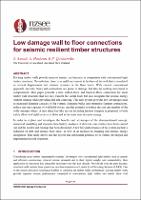| dc.description.abstract | Rocking timber walls provide superior seismic performance in comparison with conventional light timber structures. Nevertheless, there is an uplift movement at the base of the wall that is translated as vertical displacement and rotation demands at the floor levels. With current conventional approach, not only floors and connections are prone to damage, but also the rocking movement is compromised. This paper presents a new wall-to-floor and beam-to-floor connection for mass timber wall structures that not only transfer the lateral loads but also dissipates the seismic energy without damage while providing full self-centering. This new system provides few advantages such as increased damping capacity of the system, eliminate bulky and expensive fastener connections, reduce size and capacity of wall hold-downs, and the potential to reduce the size and number of the walls amongst others. A new shear key like system including friction dampers is proposed, to both safely allow wall uplift relative to floor and at the same time dissipate energy. In order to explore and investigate the benefits and advantages of the aforementioned concept, numerical modelling and dynamic time history analyses of different case studies have been carried out and the results and findings has been discussed. | |

